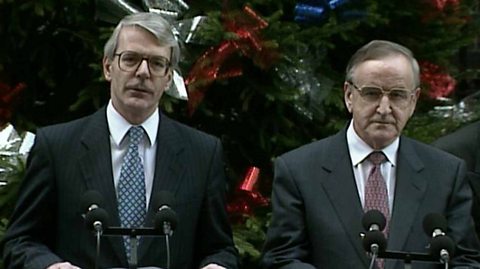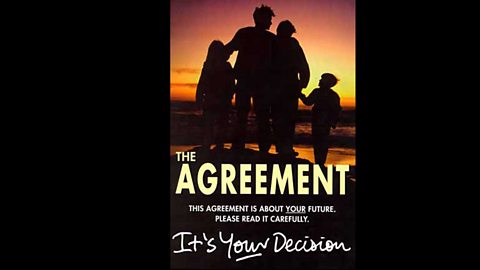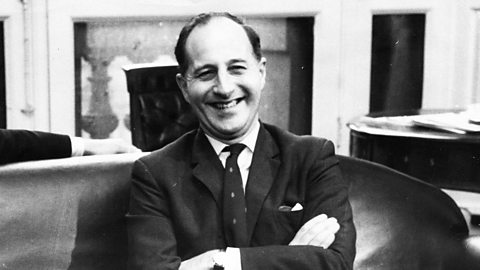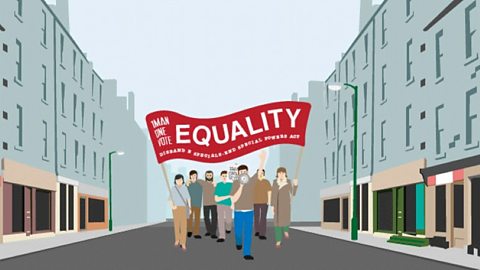Background
The hunger strikeA form of protest where a person refuses to eat until certain demands are met. and their aftermath changed the political situation in Northern Ireland massively.
The growth of Sinn FÃĐinAn Irish republican party. Founded in Dublin in 1905, Sinn FÃĐin came to prominence in the aftermath of the 1916 Easter Rising. Its subsequent growth in popularity led to Sinn FÃĐin candidates winning the majority of Irish seats in the December 1918 General Election. Subject to a number of splits in subsequent years, the party maintained its association with the Irish Republican Army (IRA) and, post-1969, the Provisional Irish Republican Army (PIRA).. was challenging the position of the Social Democratic and Labour Party (SDLP)An Irish nationalist party in Northern Ireland. When it was set up in August 1970, the SDLP was moderately left wing on social and economic issues. At the same time, the party sought political reforms within Northern Ireland and the eventual re-unification of Ireland. as the main nationalist party.
Against this backdrop, the London and Dublin governments decided to work more closely together.
The outcome was the Anglo-Irish Agreement.
The Anglo-Irish Agreement

On 15 November 1985, Prime Minister Margaret Thatcher and TaoiseachThe prime minister of the Republic of Ireland (formerly Ãire). The word is Irish for chieftain. Garrett FitzGerald signed the Anglo-Irish Agreement.
There are a number of reasons why both governments decided to do so:
- The British knew that nationalistPeople who believe their country should be independent from other nations. For example, Irish nationalists, who want Ireland to be fully independent of Britain. hostility to them would have to be removed if âthe Troublesâ were ever to be ended.
- The Irish believed that if this nationalist hostility towards the British was ended, support for Sinn FÃĐinAn Irish republican party. Founded in Dublin in 1905, Sinn FÃĐin came to prominence in the aftermath of the 1916 Easter Rising. Its subsequent growth in popularity led to Sinn FÃĐin candidates winning the majority of Irish seats in the December 1918 General Election. Subject to a number of splits in subsequent years, the party maintained its association with the Irish Republican Army (IRA) and, post-1969, the Provisional Irish Republican Army (PIRA).. and the Provisional Irish Republican Army (PIRA)Irish republican paramilitary group formed when members split from the Official IRA (OIRA) in 1969. campaign would disappear.
Terms of the Agreement
As part of the Agreement, both governments agreed to set up an intergovernmental conferenceA committee made up of members of two governments. chaired by the Irish Foreign Minister and the Secretary of StateA politician who is in charge of a government department and who is usually a member of the Cabinet. for Northern Ireland.
It would look after issues relating to:
- Security
- Law
- Politics
The Intergovernmental Conference would also work on improving general co-operation between both parts of the island.
A permanent secretariatStaffed by civil servants, this carries out the main administrative duties associated with governmental, intergovernmental or sometimes non-governmental organisations. would provide the Intergovernmental Conference with administrative help.
It would be staffed by civil servants from both Belfast and Dublin.
It was also agreed that until there was agreement on power sharing between Northern Irelandâs parties there would be no further attempt to introduce devolutionThe transfer of some powers from a central government to a more local level, eg from the UK government to the Northern Ireland government. .
As with the 1973 Sunningdale Agreement, the Anglo-Irish Agreement:
- Accepted that the Dublin government had to have an input into how Northern Ireland was run.
- Included an acceptance by the Irish government that Irish unity would only happen in the long term and would require the support of a majority of the people from Northern Ireland.
Reaction
To become law, the Anglo-Irish Agreement had to be passed by the Parliaments in London and Dublin.
While this did not prove to be a problem, the Agreement did face a range of reactions across the British Isles.
Unionists
- The unionistA person who believes the union between Britain and Northern Ireland should continue. population reacted very badly to the signing of the Anglo-Irish Agreement, which came as a complete shock.
- They felt betrayed by Thatcherâs government and felt that they would end up having to join a united Ireland.
- At the same time, the pro-Union Alliance Party of Northern Ireland (APNI)A liberal, centre ground political party in Northern Ireland. Although broadly unionist when it was founded in April 1970, its MLAs designated as âOtherâ in the Northern Ireland Assembly rather than âUnionistâ or âNationalistâ. was more positive about the Agreementâs potential to bring peace to Northern Ireland.
Nationalists
- Of all Northern Irelandâs parties, the Social Democratic and Labour Party (SDLP)An Irish nationalist party in Northern Ireland. When it was set up in August 1970, the SDLP was moderately left wing on social and economic issues. At the same time, the party sought political reforms within Northern Ireland and the eventual re-unification of Ireland. had most to be pleased about.It had been kept up to date about the negotiations leading up to the Agreement by the Dublin government.
- The SDLP believed that the Agreement could allow unionistA person who believes the union between Britain and Northern Ireland should continue. and nationalistPeople who believe their country should be independent from other nations. For example, Irish nationalists, who want Ireland to be fully independent of Britain. to live together in peace.
Republicans
- The Agreement was rejected by Sinn FÃĐinAn Irish republican party. Founded in Dublin in 1905, Sinn FÃĐin came to prominence in the aftermath of the 1916 Easter Rising. Its subsequent growth in popularity led to Sinn FÃĐin candidates winning the majority of Irish seats in the December 1918 General Election. Subject to a number of splits in subsequent years, the party maintained its association with the Irish Republican Army (IRA) and, post-1969, the Provisional Irish Republican Army (PIRA)...
- Irish republicanA person who wants to establish an all Ireland republic completely independent of Britain. argued that by recognising the existence of Northern Ireland in the Agreement, the Dublin government had made partition/partitionedThe division of a country into two regions. more permanent.
In the Republic of Ireland
- While the Republicâs Fine GaelA descendant of the pro Anglo-Irish Treaty Cumann na nGaedheal, Fine Gael has led a number of coalition governments./Labour government welcomed the Agreement, the main opposition party - Fianna FÃĄilAn anti Anglo-Irish Treaty party when founded by Ãamon de Valera in 1926, Fianna FÃĄil has held power for most of the years since 1932. â condemned the deal.
- Its main concern was the Irish governmentâs acceptance of Britainâs right to be in Northern Ireland.
- Opposition to the Agreement was also expressed by Senator Mary Robinson, a key member of the governing Labour Party.
- She resigned from the party in support of unionistA person who believes the union between Britain and Northern Ireland should continue. opposition to the Agreement.
In Britain
- While the Agreement was easily passed by the WestminsterThe London location of the British government. Parliament, some members of Margaret Thatcherâs government were not as happy.
- Chief among these was Ian Gow, a Minister in the Treasury Department.
- Gow resigned from the government in protest at the Agreement - he claimed that it had only been agreed due to the pressure of paramilitaryA person or organisation that operates like a military force, but is not part of a country's official armed forces. violence and argued it would only make the situation worse.
The unionist campaign of opposition
The unionistA person who believes the union between Britain and Northern Ireland should continue. population was so angered by the Anglo-Irish Agreement that it decided to try and destroy it by a series of protests and other actions.
These included:
- Protest marches across Northern Ireland (which sometimes became violent).
- A rally to oppose the Agreement. Held in front of the City Hall in Belfast on 23 November 1985, this gathering was attended by over 100,000 people.
- A âDay of Actionâ, held on 3 March 1986. This event brought most of Northern Ireland to a standstill. By and large it was a peaceful protest, but in a few places the âDay of Actionâ ended in violence.
- A campaign of civil disobedienceA form of peaceful protest in which someone refuses to obey certain laws because they believe they are unjust. which included:
- Unionist MPs refusing to attend the WestminsterThe London location of the British government. Parliament.
- Unionist leaders refusing to meet members of the British government.
- Unionist councils refusing to set ratesA payment made by householders to their local council. for their area.
- The resignation - by all 15 unionist MPs â of their membership of the Westminster Parliament. This action meant that new elections had to be held for these 15 constituencyAn area represented by an elected MP.. The unionistsâ intention was to show â by the number of votes gained by their candidates â how much support they had in their campaign of opposition to the Agreement.
While these actions were mostly peaceful, loyalistA person who, in terms of culture, identity and politics, retains a strong loyalty to Britain and firmly opposes a united Ireland. paramilitaryA person or organisation that operates like a military force, but is not part of a country's official armed forces. showed their opposition to the Anglo-Irish Agreement by:
- Trying to frighten members of the Royal Ulster Constabulary (RUC)Police force in Northern Ireland from 1922 to 2001. â who were seen as key to making the Agreement work â through the use of violence and intimidationBehaviour that threatens an individual or group..
- Setting up a new paramilitary organisation â Ulster Resistance â to oppose the Agreement.
Impact of the campaign
So did the campaign of opposition to the Anglo-Irish Agreement work?
- While unionistA person who believes the union between Britain and Northern Ireland should continue. candidates won over 420,000 votes in the by-elections that followed the resignation of their WestminsterThe London location of the British government. seats, one seat (Newry and Armagh) was won by the Social Democratic and Labour Party (SDLP)An Irish nationalist party in Northern Ireland. When it was set up in August 1970, the SDLP was moderately left wing on social and economic issues. At the same time, the party sought political reforms within Northern Ireland and the eventual re-unification of Ireland. .
- The Westminster Parliament was so big (with 650 MPs) that the non-attendance of 14 unionist MPs was not really noticed.
- As local councils within Northern Ireland had little or no power, as things stood, their refusal to use their âpowersâ made no difference to how Northern Ireland was run.
By September 1987, when the unionist leaders agreed to talk to British ministers again, it was clear that the campaign to destroy the Agreement had failed.
For more information, including archive clips, on the Anglo-Irish Agreement, 1985, visit ģÉČËŋėĘÖ: Ten Chapters of the Northern Ireland Troubles - ()
WATCH: Anglo-Irish Agreement
Test your knowledge
More on Changing relations: Northern Ireland and its neighbours, 1965-98
Find out more by working through a topic
- count10 of 11

- count11 of 11

- count1 of 11

- count2 of 11
